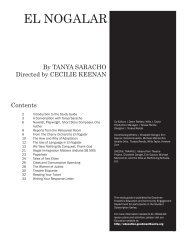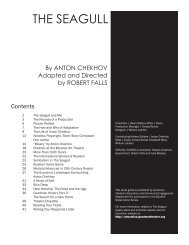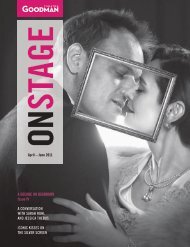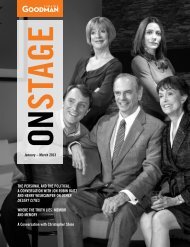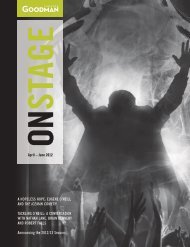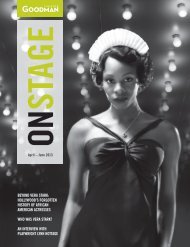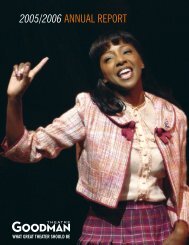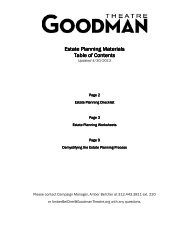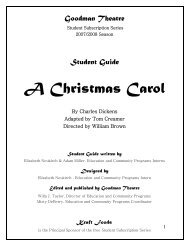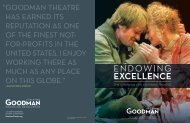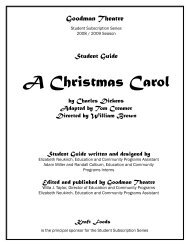Magnolia, atlanta and dr. Martin luther king jr. a ... - Goodman Theatre
Magnolia, atlanta and dr. Martin luther king jr. a ... - Goodman Theatre
Magnolia, atlanta and dr. Martin luther king jr. a ... - Goodman Theatre
You also want an ePaper? Increase the reach of your titles
YUMPU automatically turns print PDFs into web optimized ePapers that Google loves.
March – May 2009<br />
<strong>Magnolia</strong>, <strong>atlanta</strong> <strong>and</strong><br />
<strong>dr</strong>. <strong>Martin</strong> <strong>luther</strong> <strong>king</strong> <strong>jr</strong>.<br />
A conversation with regina taylor,<br />
playwright of magnolia<br />
Interview: Ghostwritten Playwright<br />
Naomi Iizuka <strong>and</strong> Director Lisa Portes
<strong>Goodman</strong> <strong>Theatre</strong> Artistic Director | Robert Falls<br />
<strong>Goodman</strong> <strong>Theatre</strong> Executive Director | Roche Schulfer<br />
March – May 2009<br />
CONTENTS<br />
Volume 24 #3<br />
In the Albert<br />
1 Why <strong>Magnolia</strong>?<br />
2 Atlanta, 1963 <strong>and</strong> the Legacy of Dr. <strong>Martin</strong> Luther King Jr.<br />
6 Where Peachtree Street Meets Sweet Auburn in 2009<br />
7 An Interview with Playwright Regina Taylor<br />
In the Owen<br />
10 An Interview with Playwright Naomi Iizuka <strong>and</strong> Director Lisa Portes<br />
12 A Taste of Truth: How Food Shapes Personal Identity<br />
13 Once Upon a Time… The Story of “Rumpelstiltskin”<br />
In the Wings<br />
14 Little Village Lawndale High School Reflects Dr. King’s Legacy<br />
15 Ta<strong>king</strong> the Stage: A Celebration of Women in Theater<br />
The <strong>Goodman</strong> Offers FREE Readings as Part of Science Chicago<br />
Scene at the <strong>Goodman</strong><br />
16 A Desirable Evening<br />
17 Ruined Opens at Manhattan <strong>Theatre</strong> Club<br />
Desire Under the Elms Premiere Night<br />
Off Stage<br />
18 Celebrating an Historic Gift to the <strong>Goodman</strong>’s Future<br />
19 The <strong>Goodman</strong> Receives Second Joyce Award<br />
For Subscribers<br />
21 Calendars<br />
Co-Editors | Lara Ehrlich, Lori Kleinerman,<br />
Tanya Palmer<br />
Graphic Designer | Tyler Engman<br />
Production Manager | Lara Ehrlich<br />
Contributing Writers/Editors | Neena Arndt,<br />
Jeff Ciaramita, Lara Ehrlich, Lisa Feingold,<br />
Katie Frient, Kim Furganson, John Earl<br />
Jelks, Lori Kleinerman, Julie Massey,<br />
Elizabeth Neukirch, Tanya Palmer, Scott<br />
Po<strong>dr</strong>aza, Victoria Ro<strong>dr</strong>iguez, Denise<br />
Schneider, Steve Scott, Kim Swinton, Willa<br />
J. Taylor, Chris Tiffany, Jennifer Whittemore<br />
OnStage is published in conjunction with<br />
<strong>Goodman</strong> <strong>Theatre</strong> productions. It is designed<br />
to serve as an information source for<br />
<strong>Goodman</strong> <strong>Theatre</strong> Subscribers. For ticket <strong>and</strong><br />
subscription information call 312.443.3810.<br />
Cover: Photo of Annette O’Toole <strong>and</strong> John<br />
Jelks by Brian Warling. Design/direction by<br />
Kelly Rickert.<br />
<strong>Goodman</strong> productions are made possible<br />
in part by the National Endowment for<br />
the Arts; the Illinois Arts Council, a state<br />
agency; <strong>and</strong> a CityArts 4 program grant<br />
from the City of Chicago Department of<br />
Cultural Affairs.<br />
Written comments <strong>and</strong><br />
inquiries should be sent to:<br />
The Editor, OnStage<br />
<strong>Goodman</strong> <strong>Theatre</strong><br />
170 North Dearborn Street<br />
Chicago, IL 60601<br />
or e-mail us at:<br />
OnStage@<strong>Goodman</strong><strong>Theatre</strong>.org
IN THE ALBERT<br />
From the Artistic Director<br />
Photo by Eric Y. Exit.<br />
Why <strong>Magnolia</strong>?<br />
Regina Taylor’s magnificent new play, <strong>Magnolia</strong>, offers a look at a time of seismic change in American society, in<br />
a city that was at the epicenter of that change. Atlanta in 1963 was in many ways typical of American cities of<br />
the time: a thriving cultural <strong>and</strong> social center for both black <strong>and</strong> white Americans, but one in which those societies<br />
existed steadfastly apart from each other in worlds that rarely intersected. When in January of 1963 the mayor of the<br />
city erected a physical barricade meant to maintain racial separation, the ramifications in both the black <strong>and</strong> white<br />
communities were immediate <strong>and</strong> unsettling, causing an inexorable change that epitomized the social revolutions that<br />
would consume the rest of the decade—<strong>and</strong> beyond.<br />
Although it is inspired in part by Chekhov’s The Cherry Orchard, <strong>Magnolia</strong> is the wholly American story of the families<br />
<strong>and</strong> individuals who were forced to finally deal with generational, societal <strong>and</strong> political issues that had been brewing<br />
for decades, through generations of genteel coexistence. As the world evolves, its inhabitants struggle to find their<br />
own voices in the face of evolution, with results that are both devastating <strong>and</strong> triumphant. In doing so, each character<br />
in the play must come to terms with the changes of the present as well as the issues of the past that have both<br />
divided <strong>and</strong> united them. As she has done so eloquently in such other works as Crowns <strong>and</strong> The Dreams of Sarah<br />
Breedlove, Regina imbues each of her characters with passion, grace <strong>and</strong> poetry, honoring their individual <strong>and</strong> collective<br />
struggles with dignity <strong>and</strong> compassion.<br />
It is a great pleasure for me to welcome Regina back to the <strong>Goodman</strong> where she has created some of our most distinguished<br />
works, <strong>and</strong> to pair her with Anna Shapiro, one of our country’s finest directors. In the aftermath of one<br />
of the most historic elections in America’s history, it is especially fitting that these artists <strong>and</strong> their gifted collaborators<br />
can take us back to another time of unprecedented change <strong>and</strong> possibility, through the finely wrought language <strong>and</strong><br />
indelible images of <strong>Magnolia</strong>.<br />
Robert Falls<br />
Artistic Director<br />
1
IN THE ALBERT<br />
Atlanta, 1963 <strong>and</strong> the<br />
Legacy of Dr. <strong>Martin</strong><br />
Luther King Jr.<br />
By Tanya Palmer<br />
2
OPPOSITE: Photo of Dr. <strong>Martin</strong> Luther King Jr. in the<br />
Vine City neighborhood in Atlanta, Georgia, while residents<br />
protested their living conditions. Courtesy of the<br />
Atlanta History Center, Bill Wilson Collection. RIGHT:<br />
Photo of Ebenezer Baptist Church in Atlanta, Georgia,<br />
courtesy of photographer Stu Jenks. Photo of Peachtree<br />
Street <strong>and</strong> Auburn Avenue courtesy of Geographic<br />
Places, Lane Brothers Photographers Collection <strong>and</strong><br />
Tracy O’Neill Collection, Special Collections Department,<br />
Georgia State University Library.<br />
Set in Atlanta, Georgia, in early 1963,<br />
<strong>Magnolia</strong> captures a place <strong>and</strong> time when<br />
all assumptions were being reexamined<br />
<strong>and</strong> the earth was shifting under people’s<br />
feet. The impetus for the play came from<br />
playwright Regina Taylor’s desire to honor<br />
the legacy of Dr. <strong>Martin</strong> Luther King Jr.<br />
She began her journey by studying the<br />
people <strong>and</strong> history of King’s birthplace.<br />
Born on January 15, 1929, King was the<br />
eldest son of Alberta King (née Williams)<br />
<strong>and</strong> the Reverend Mike King, who later<br />
changed both his <strong>and</strong> his son’s name to<br />
<strong>Martin</strong> Luther in honor of the 16th century<br />
theologian. King’s maternal gr<strong>and</strong>father,<br />
A.D. Williams, was a former slave<br />
preacher who had worked his way up in<br />
Atlanta’s black community to become the<br />
preacher at Ebenezer Baptist Church. It<br />
was this pulpit that King’s father would<br />
assume in due time.<br />
The Atlanta of King’s childhood suffered<br />
from the same racist acrimony <strong>and</strong> violence<br />
as the rest of the South, but what<br />
set the city apart from its region was<br />
its thriving black community. Auburn<br />
Avenue, the street where King grew up<br />
<strong>and</strong> Ebenezer Baptist Church stood, was<br />
a lively strip of restaurants, offices, small<br />
businesses <strong>and</strong> nightspots that came to<br />
be known as Sweet Auburn.<br />
In his historical narrative Where<br />
Peachtree Meets Sweet Auburn journalist<br />
Gary M. Pomerantz charts the parallel<br />
histories of two Atlantas—one black <strong>and</strong><br />
centered around Sweet Auburn, the other<br />
white, wealthy <strong>and</strong> centered around<br />
Peachtree Street. In a telling episode,<br />
Pomerantz describes a <strong>dr</strong>ive he took with<br />
Maynard Jackson—the former mayor of<br />
Atlanta <strong>and</strong> the first black mayor of a<br />
<strong>Magnolia</strong> Synopsis<br />
Atlanta, 1963. Even as <strong>Martin</strong> Luther King Jr. inspires Atlanta’s black citizens to fight<br />
passionately for their civil rights, the new mayor erects “Peyton Wall” to restrict where<br />
they can live. Amid these churning social currents, the <strong>Magnolia</strong> Estate faces foreclosure,<br />
pitting the sensual, free-spirited heiress Lily Forrest against Thomas, a strong-willed businessman<br />
who lays claim to the estate where his ancestors were slaves. As we welcome<br />
the first African American president into the White House, this poignant <strong>and</strong> timely world<br />
premiere by Regina Taylor reminds us how much of Dr. King’s <strong>dr</strong>eam has been realized—<br />
<strong>and</strong> how much is yet to be achieved. Directed by Anna D. Shapiro, the Tony Awardwinning<br />
director of August: Osage County.<br />
major southern city—around Jackson’s<br />
gr<strong>and</strong>parents’ old neighborhood.<br />
Jackson pointed to a street sign<br />
<strong>and</strong> said, ‘What’s it say?’ ‘Glen Iris.’<br />
Across the street, the street sign said<br />
‘R<strong>and</strong>olph.’ You know why? Racial<br />
living patterns. Whites didn’t want to<br />
live on the same street as blacks. So<br />
blacks lived on ‘R<strong>and</strong>olph Street’ <strong>and</strong><br />
whites lived on ‘Glen Iris.’<br />
In 1895, Atlanta had played host to the<br />
Cotton States <strong>and</strong> International Exposition<br />
where Booker T. Washington delivered<br />
a famous speech known as the “Atlanta<br />
Compromise.” In this speech Washington<br />
said, “In all things that are purely social,<br />
we can be as separate as the fingers, yet<br />
one as the h<strong>and</strong> in all things essential to<br />
mutual progress.” This pragmatic, measured<br />
approach to race relations became<br />
central to Atlanta’s character <strong>and</strong> is<br />
represented in <strong>Magnolia</strong> on both sides of<br />
the racial divide. The character Thomas,<br />
3
IN THE ALBERT<br />
LEFT: Photo of Atlanta Mayor Ivan Allen Jr. <strong>and</strong> actress<br />
Olivia de Havill<strong>and</strong> in a parade on Peachtree Street in<br />
Atlanta, Georgia, celebrating the re-release of the motion<br />
picture Gone with the Wind. Courtesy of the Atlanta<br />
History Center, Joe McTyre Collection. OPPOSITE: Photo<br />
of a line of mourners during the funeral procession for Dr.<br />
<strong>Martin</strong> Luther King Jr. in Atlanta, Georgia. Courtesy of the<br />
Atlanta History Center, Floyd Jillson Collection.<br />
a successful black real estate developer,<br />
explains it this way: “Got my own colored<br />
doctor, policeman, got Herndon for my<br />
banker—I don’t need to sleep let alone<br />
pee next to no white folk. Everything I<br />
need I got, right here in Sweet Auburn.”<br />
William, a white restaurant owner who<br />
has recently desegregated his restaurant,<br />
explains it like this: “Colored protest<br />
is bad for business. Atlanta’s no Little<br />
Rock…Myself, I’ll never <strong>dr</strong>ink from the<br />
same fountain as a Negro.”<br />
As the late 1950s <strong>and</strong> early 1960s<br />
brought a tidal wave of change to the<br />
established order in the South, Atlanta<br />
promoted itself as “the city too busy<br />
to hate.” Following the 1954 Brown v.<br />
Board of Education of Topeka, Kansas,<br />
decision, Washington pressured southern<br />
cities to integrate their schools. Little<br />
Rock, Arkansas, went first—<strong>and</strong> when<br />
nine black students were admitted to <strong>and</strong><br />
attempted to enter Central High School,<br />
the city erupted in violence that persisted<br />
until President Eisenhower dispatched<br />
the 101st Airborne Division to restore<br />
order. When it came time for Atlanta to<br />
integrate, Mayor William B. Hartsfield<br />
vowed that “what happened in Little<br />
Rock won’t happen here.” On August<br />
30, 1961, nine chil<strong>dr</strong>en were peacefully<br />
integrated into four Atlanta high schools.<br />
Civic leaders boasted that it was “the<br />
silence heard around the world.”<br />
Though <strong>Martin</strong> Luther King Jr. initially<br />
resisted following in his father’s footsteps,<br />
he decided to enter the ministry<br />
during his senior year at Atlanta’s<br />
Morehouse College. He studied first at<br />
Crozer Theological Seminary in Chester,<br />
Pennsylvania, <strong>and</strong> then received a doctorate<br />
at Boston University, where he<br />
met <strong>and</strong> married Coretta Scott. After<br />
graduation, he <strong>and</strong> Coretta traveled<br />
south to Montgomery, Alabama, where<br />
King served as the pastor at Dexter<br />
Avenue Baptist Church. It was during<br />
King’s five years in Montgomery that he<br />
was catapulted to international fame for<br />
his role in the burgeoning Civil Rights<br />
Movement, beginning with his leadership<br />
during the Montgomery bus boycott.<br />
In 1959, King moved back to Atlanta<br />
where he established the Southern<br />
Christian Leadership Conference headquartered<br />
on Auburn Avenue <strong>and</strong> joined<br />
his father as co-pastor of Ebenezer<br />
Baptist Church.<br />
By 1963, the year in which <strong>Magnolia</strong><br />
is set, civic leaders were struggling to<br />
maintain Atlanta’s image as “the city<br />
too busy to hate,” but the strain was<br />
starting to show.<br />
By 1963, the year in which <strong>Magnolia</strong><br />
is set, civic leaders were struggling<br />
to maintain Atlanta’s image as “the<br />
city too busy to hate,” but the strain<br />
was starting to show. In 1960, King<br />
participated in a sit-in to protest segregation<br />
at Rich’s Department Store in<br />
downtown Atlanta. He was arrested <strong>and</strong><br />
sentenced to four months in Reidsville<br />
Penitentiary. In 1961, Ivan Allen Jr.,<br />
member of a prominent white Atlanta<br />
family <strong>and</strong> president of the Atlanta<br />
4
The Civil Rights Movement, 1954–1968<br />
May, 1954 In Brown v. Board of Education<br />
of Topeka, Kansas, The Supreme Court<br />
unanimously rules public school segregation<br />
unconstitutional.<br />
August, 1954 In Mississippi, 14-yearold<br />
Emmett Till is murdered for allegedly<br />
whistling at a white woman.<br />
December, 1955 In Montgomery,<br />
Alabama, Rosa Parks is arrested for<br />
refusing to give up her seat on the bus<br />
to a white passenger. Dr. <strong>Martin</strong> Luther<br />
King Jr. leads a bus boycott that lasts<br />
for more than a year.<br />
February, 1957 In Greensboro, North<br />
Carolina, four black students stage a<br />
sit-in at a segregated lunch counter in<br />
Woolworth’s.<br />
September, 1957 In Little Rock,<br />
Arkansas, President Eisenhower sends<br />
federal troops <strong>and</strong> the National Guard<br />
to escort the “Little Rock Nine” into<br />
Central High School.<br />
November, 1960 John F. Kennedy is<br />
elected President of the United States.<br />
1961 Students volunteer for bus trips<br />
(“freedom rides”) through the South to<br />
test the new laws prohibiting segregation<br />
in interstate travel facilities.<br />
October, 1962 President Kennedy sends<br />
federal troops to the University of<br />
Mississippi when riots break out over<br />
the enrollment of the first black student,<br />
James Meredith.<br />
December, 1962 Atlanta mayor Ivan<br />
Allen Jr. orders the erection of Peyton<br />
Wall to separate a white neighborhood<br />
from an adjacent black neighborhood.<br />
1963 Regina Taylor’s play <strong>Magnolia</strong><br />
takes place.<br />
April, 1963 While protesting in<br />
Birmingham, Alabama, Dr. <strong>Martin</strong> Luther<br />
King Jr. is imprisoned <strong>and</strong> writes the<br />
famous “Letter from Birmingham Jail.”<br />
June, 1963 Mississippi’s NAACP field<br />
secretary, Medgar Evers, is murdered.<br />
August, 1963 In Washington, D.C.,<br />
Dr. <strong>Martin</strong> Luther King Jr. delivers his<br />
famous “I Have a Dream” speech.<br />
November, 1963 President John F.<br />
Kennedy is assassinated in Dallas, Texas.<br />
January, 1964 The 24th Amendment<br />
abolishes the poll tax.<br />
March, 1964 In Selma, Alabama, in<br />
an incident the media dubs “Bloody<br />
Sunday,” police use clubs, whips <strong>and</strong><br />
tear gas on black protestors.<br />
July, 1964 President Johnson signs the<br />
Civil Rights Act of 1964.<br />
August, 1964 The Ku Klux Klan murders<br />
three civil-rights workers in Neshoba<br />
County, Mississippi.<br />
December, 1964 Dr. <strong>Martin</strong> Luther King<br />
Jr. is awarded the Nobel Peace Prize.<br />
February, 1965 Malcolm X is assassinated<br />
in Harlem, New York.<br />
August, 1965 Congress passes the Voting<br />
Rights Act of 1965.<br />
September, 1965 President Johnson<br />
issues Executive Order 11246, enforcing<br />
affirmative action.<br />
April, 1968 Dr. <strong>Martin</strong> Luther King Jr. is<br />
assassinated in Memphis, Tennessee.<br />
Chamber of Commerce, negotiated a<br />
peaceful desegregation of the city’s<br />
lunch counters. That same year, Allen<br />
ran for mayor <strong>and</strong> won, defeating Lester<br />
Maddox, an Atlanta restaurant owner<br />
who ran on a strong segregationist platform.<br />
Despite his own segregationist<br />
past, Allen had courted—<strong>and</strong> won—<br />
the endorsement of The Atlanta Negro<br />
Voters League, key to securing the support<br />
of the city’s black community.<br />
Like Mayor Hartsfield before him, Allen<br />
saw the “race issue” in largely pragmatic<br />
terms. During the summer of 1962, however,<br />
less than a year into his first term as<br />
mayor, Allen’s approach was sorely tested.<br />
Although the city was in the midst of<br />
an economic boom, the median income<br />
of black families was less than half that<br />
of white families. And although blacks<br />
represented 40 percent of the city’s population,<br />
they lived on only 24 percent of<br />
the residential l<strong>and</strong>. That summer, black<br />
realtors had started to <strong>dr</strong>ive through the<br />
Utoy-Peyton Forest subdivision of Cascade<br />
Heights, a white upper-middle-class<br />
enclave of Atlanta. The interest of black<br />
realtors stirred the apprehension of white<br />
residents determined to prevent blacks<br />
from buying into their community. The<br />
Cascade Heights residents turned to Ivan<br />
Allen Jr. for help, as<strong>king</strong> that he close<br />
the two roads that connected Cascade<br />
Heights to an adjacent black neighborhood.<br />
On December 19, with the support<br />
of 13 members of the Atlanta Board of<br />
Aldermen, Allen obliged.<br />
There’s a story—perhaps apocryphal—<br />
that as Mayor Hartsfield was h<strong>and</strong>ing<br />
over the keys to the mayor’s office, he<br />
advised his young successor “never [to]<br />
make a mistake you can take a picture<br />
of.” In erecting two wood <strong>and</strong> steel barriers,<br />
each affixed with the sign “Road<br />
Closed,” Atlanta’s new mayor had made<br />
the city’s racial lines visible to the world.<br />
Likened to the Berlin Wall, Atlanta’s<br />
Peyton Wall generated unwanted attention.<br />
It stood as Dr. <strong>Martin</strong> Luther<br />
King Jr. was arrested in Birmingham,<br />
Alabama, for his part in a non-violent<br />
protest conducted against segregation.<br />
There he penned the famous “Letter from<br />
Birmingham Jail” decrying the evils of<br />
segregation <strong>and</strong> ma<strong>king</strong> an impassioned<br />
argument for the need to resist injustice<br />
now—<strong>and</strong> in the weeks <strong>and</strong> months following<br />
the events in Birmingham, there<br />
was an explosion of black protest on an<br />
unprecedented scale.<br />
Surprised by the force of the protests, the<br />
Kennedy administration moved to pass<br />
a sweeping Civil Rights Bill. Sensing an<br />
opportunity to influence the federal government,<br />
King <strong>and</strong> his fellow civil rights lead-<br />
5
IN THE ALBERT<br />
ers organized the March on Washington—<br />
an event which culminated in King’s<br />
famous “I Have a Dream” speech:<br />
We have also come to this hallowed<br />
spot to remind America of the fierce<br />
urgency of Now. This is no time to<br />
engage in the luxury of cooling off<br />
or to take the tranquilizing <strong>dr</strong>ug of<br />
gradualism. Now is the time to make<br />
real the promises of democracy. Now<br />
is the time to rise from the dark <strong>and</strong><br />
desolate valley of segregation to the<br />
sunlit path of racial justice. Now is the<br />
time to lift our nation from the quick<br />
s<strong>and</strong>s of racial injustice to the solid<br />
rock of brotherhood. Now is the time<br />
to make justice a reality for all of<br />
God’s chil<strong>dr</strong>en.<br />
It would be fatal for the nation to<br />
overlook the urgency of the moment.<br />
This sweltering summer of the Negro’s<br />
legitimate discontent will not pass until<br />
there is an invigorating autumn of freedom<br />
<strong>and</strong> equality. Nineteen sixty-three<br />
is not an end, but a beginning.<br />
On March 1, 1963, 72 days after Ivan<br />
Allen Jr. erected the Peyton Wall barricades,<br />
the Fulton County Superior Court<br />
ruled the signs unconstitutional <strong>and</strong><br />
Atlanta’s city hall was granted four days<br />
to remove them. Ivan Allen Jr. ordered<br />
them removed 20 minutes later. That<br />
same year, Allen moved to dismantle<br />
other walls that divided his city: he lobbied<br />
successfully for Atlanta’s first black<br />
firemen, empowered black policemen<br />
to arrest whites, desegregated Atlanta’s<br />
baseball park, downtown theaters <strong>and</strong><br />
municipal swimming pools <strong>and</strong> requested<br />
that downtown businesses desegregate to<br />
“maintain the city’s healthy climate.”<br />
Today, 40 years after Dr. <strong>Martin</strong> Luther King<br />
Jr.’s death, as we welcome the first African<br />
American president into the White House,<br />
Taylor’s play reminds us how much of<br />
Dr. King’s <strong>dr</strong>eam has been realized—<strong>and</strong><br />
how much is still left to be achieved.<br />
LEFT: Photo of Peachtree Street courtesy of Geographic<br />
Places, Lane Brothers Photographers Collection <strong>and</strong><br />
Tracy O’Neill Collection, Special Collections Department,<br />
Georgia State University Library.<br />
Where Peachtree Street<br />
Meets Sweet Auburn in 2009<br />
Although Atlanta was the birthplace of the<br />
Civil Rights Movement <strong>and</strong> is known as the<br />
capital of the New South, it is second only<br />
to Chicago as the city with the most segregated<br />
housing patterns in the United States.<br />
During the period in which <strong>Magnolia</strong> takes<br />
place, segregation was embodied by the<br />
difference between the city’s two major<br />
streets: Peachtree Street <strong>and</strong> Sweet Auburn.<br />
Once the center of black life in Atlanta,<br />
Sweet Auburn was—<strong>and</strong> still is—an innercity<br />
neighborhood victim to inner-city problems.<br />
In 1992, Sweet Auburn was named<br />
one of America’s 11 Most Endangered<br />
Historic Places, which prompted the creation<br />
of the Historic District Development<br />
Corporation (HDDC) to help preserve the<br />
area’s cultural <strong>and</strong> political history, beginning<br />
with the birthplace of Dr. <strong>Martin</strong><br />
Luther King Jr. The HDDC has since<br />
worked to develop the neighborhood while<br />
constructing affordable housing to maintain<br />
its lower-income residents.<br />
Once the major street for Atlanta’s wealthy<br />
white population, Peachtree has inspired<br />
71 other ‘Peachtree’ streets throughout the<br />
city. The original Peachtree Street has often<br />
been compared to Broadway, even inspiring<br />
Frank Sinatra to sing, “There’s nothing<br />
can compare with/Strolling along Peachtree<br />
Street with my baby on my arm.” Atlanta<br />
developed around Peachtree Street, where<br />
the majority of its municipal buildings <strong>and</strong><br />
historical l<strong>and</strong>marks were located, <strong>and</strong> it<br />
continues to evolve today. In 2007, Mayor<br />
Shirley Franklin made public a $1 billion,<br />
20-year proposal to construct modern<br />
architecture, restaurants, bars, shops <strong>and</strong><br />
apartments where some of Atlanta’s most<br />
majestic homes once stood.<br />
While Sweet Auburn <strong>and</strong> Peachtree once<br />
represented two distinct Atlantas, today<br />
both streets are developing into vibrant<br />
commercial, residential <strong>and</strong> historic roads<br />
that will one day lead to one integrated<br />
city. While blacks <strong>and</strong> whites are not yet<br />
neighbors in the capital of the New South,<br />
the distance between them has been<br />
steadily diminishing since Peyton Wall was<br />
torn down more than four decades ago.<br />
Peachtree Street today. Photo courtesy of Flip Chalfant.<br />
6
An Interview with Playwright Regina Taylor<br />
In a recent conversation with <strong>Goodman</strong><br />
Literary Manager Tanya Palmer, playwright<br />
<strong>and</strong> <strong>Goodman</strong> Artistic Associate<br />
Regina Taylor discussed her new play,<br />
<strong>Magnolia</strong>, which is set in Atlanta, Georgia,<br />
in 1962–1963, the year that Atlanta<br />
mayor Ivan Allen Jr. erected a barrier<br />
to slow the progress of integration.<br />
Tanya Palmer: I underst<strong>and</strong> that your<br />
research for <strong>Magnolia</strong> involved conducting<br />
first-h<strong>and</strong> interviews with people<br />
in Atlanta about their memories of the<br />
1960s. Was the story of Peyton Wall<br />
part of the play from the beginning, or<br />
did it come out of the interviews?<br />
Dr. King’s <strong>dr</strong>eam has been fulfilled in<br />
some ways? The presidential election of<br />
a black senator from Illinois makes this<br />
play wonderfully exciting to me right now,<br />
especially to be presenting it in Chicago.<br />
TP: One of the interesting things about<br />
the play being set in Atlanta is that<br />
while it is clearly a southern city, Atlanta<br />
approached civil rights <strong>and</strong> desegregation<br />
differently than other southern cities. Can<br />
you talk a little bit about that difference?<br />
REGINA TAYLOR<br />
RT: Atlanta was known as the black<br />
mecca of the South, just as Chicago<br />
was considered the black mecca of the<br />
North. Very clear lines separated the<br />
races in both cities, but both Atlanta<br />
<strong>and</strong> Chicago also had very prosperous<br />
black communities with strong hierarchies<br />
of people wielding power. Atlanta<br />
had Daddy King [<strong>Martin</strong> Luther King Sr.]<br />
<strong>and</strong> many other people who could wield<br />
power on both sides of the line. It was<br />
a city in which black people could own<br />
Regina Taylor: I wanted to write a play<br />
that could be produced in memory of<br />
Dr. <strong>Martin</strong> Luther King Jr. <strong>and</strong> honor his<br />
<strong>dr</strong>eams on the 40th anniversary of his<br />
death, so I started by researching the<br />
history of his birthplace, Atlanta. Peyton<br />
Wall came up in my research, <strong>and</strong> I<br />
thought ‘Oh! I didn’t know about that!’<br />
The play takes place in 1963, during a<br />
time of change <strong>and</strong> hope when the country<br />
was on the precipice of Dr. <strong>Martin</strong> Luther<br />
King Jr.’s mountain—<strong>dr</strong>eaming about the<br />
hopes <strong>and</strong> promises of the future. During<br />
the previous year, John Glenn had orbited<br />
the earth for the first time. When he<br />
returned to earth <strong>and</strong> touched American<br />
soil, he found the l<strong>and</strong>scape shifting <strong>and</strong><br />
the times changing. America had elected<br />
Kennedy the first Roman Catholic president<br />
<strong>and</strong> during that time, the invisible<br />
walls that had always divided the country<br />
<strong>and</strong> Atlanta, specifically, were becoming<br />
very visible <strong>and</strong> concrete.<br />
Writing this piece about Dr. <strong>Martin</strong> Luther<br />
King Jr.’s <strong>dr</strong>eam has been interesting,<br />
because as I was writing <strong>Magnolia</strong>,<br />
Barack Obama was elected president.<br />
And that is what propels the piece as I<br />
continue to work on it. How do we look<br />
at Atlanta, Georgia, in 1963, now that<br />
ANNA D. SHAPIRO received the 2008 Tony Award for Best Direction of a<br />
Play for August: Osage County. Directing credits at Steppenwolf <strong>Theatre</strong> Company<br />
(where she became an ensemble member in 2005) include The Pain <strong>and</strong> the Itch,<br />
I Never Sang for My Father, Man from Nebraska, Until We Find Each Other, The<br />
Drawer Boy <strong>and</strong> Side Man. Other credits include Our Town at Loo<strong>king</strong>glass <strong>Theatre</strong><br />
Company, A Number at A Contemporary <strong>Theatre</strong>, Iron at Manhattan <strong>Theatre</strong> Club,<br />
A Fair Country at Huntington <strong>Theatre</strong> Company <strong>and</strong> Traffic<strong>king</strong> in Broken Hearts<br />
at Atlantic <strong>Theatre</strong> Company. Ms. Shapiro is a graduate of the Yale School of Drama<br />
<strong>and</strong> Columbia College <strong>and</strong> the recipient of a 1996 Princess Grace Award. She<br />
joined the faculty of Northwestern University as head of the Graduate Directing<br />
Program in 2002.<br />
7
IN THE ALBERT<br />
It was a city in which black people<br />
could own their own: Atlanta’s black<br />
community had its own doctors,<br />
lawyers <strong>and</strong> bankers.<br />
their own: Atlanta’s black community<br />
had its own doctors, lawyers <strong>and</strong> bankers.<br />
So a lot of black people flocked to<br />
Atlanta for the freedom that they couldn’t<br />
experience in other parts of the South.<br />
Atlanta was built as a railroad town, so<br />
it was very much centered on business.<br />
One of the main characters in the play,<br />
Thomas, is certainly part of that system<br />
of commerce <strong>and</strong> believes in it. He feels<br />
that as a black man in this country, he<br />
can have control over his destiny <strong>and</strong> be<br />
a part of the American <strong>dr</strong>eam. He feels<br />
a great sense of freedom in his neighborhood,<br />
Sweet Auburn, <strong>and</strong> as a realtor he<br />
is a successful, profitable businessman.<br />
So he does not see a need for change.<br />
TP: Another critical character in the play is<br />
Lily, who is on the verge of change in her<br />
own life. Can you talk a little bit about Lily<br />
<strong>and</strong> her relationship with Thomas?<br />
RT: Both Thomas <strong>and</strong> Lily were born on<br />
<strong>Magnolia</strong> Estate; both have escaped the<br />
soil on which they were born to try to<br />
create their own identities. Meanwhile,<br />
the tide waters of change are flowing<br />
across America, starting with the “Little<br />
Rock Nine” <strong>and</strong> Brown v. Board of<br />
Education. This tide is hitting Atlanta<br />
<strong>and</strong> people want it to slow down. At<br />
the time, Atlanta’s Peyton area was the<br />
invisible line between black <strong>and</strong> white<br />
Atlanta. Black realtors were circling<br />
around this area, while the new mayor<br />
Ivan Allen Jr. was saying, “We are not<br />
ready for the first black family to move<br />
onto this block. We need to slow down<br />
a bit or there will be white flight across<br />
America.” So he erected a barricade.<br />
During this time, the rules of society<br />
were changing—the lines that separated<br />
black <strong>and</strong> white Atlanta were becoming<br />
less defined.<br />
As a white woman in this society, Lily<br />
found her place becoming uncertain. So<br />
she left her family’s patch of earth on<br />
<strong>Magnolia</strong> Estate; she flew the coop, traveled<br />
around the world <strong>and</strong> orbited further<br />
<strong>and</strong> further out. Until the time when the<br />
play begins, Lily has been living a bohemian<br />
lifestyle, changing her name <strong>and</strong> her<br />
identity, trying to find herself. But when the<br />
play begins, she is suddenly called back<br />
home, where she has to deal with the different<br />
parts of herself that she thought she<br />
had left behind. Both Thomas <strong>and</strong> Lily are<br />
called back to <strong>Magnolia</strong> Estate, where they<br />
have to deal with their roots.<br />
TP: Another one of the source materials for<br />
<strong>Magnolia</strong> is The Cherry Orchard, by the<br />
great Russian playwright Anton Chekhov.<br />
RT: Yes, the plot is inspired by The<br />
Cherry Orchard, but the play is as<br />
<strong>Magnolia</strong> Blossoms with Support from Target<br />
<strong>Goodman</strong> <strong>Theatre</strong> is proud to salute<br />
Target for its generous support as the Lead<br />
Corporate Sponsor for <strong>Magnolia</strong> <strong>and</strong> returning<br />
Lead Diversity Night Sponsor. With<br />
<strong>Magnolia</strong>, Target continues its partnership<br />
with the <strong>Goodman</strong> on plays that create a<br />
cross-cultural experience for Chicago audiences<br />
<strong>and</strong> inspire broad participation by a<br />
diverse group of theatergoers.<br />
“Target is thrilled to partner with the<br />
<strong>Goodman</strong> to sponsor this world-premiere<br />
production of <strong>Magnolia</strong> by Regina<br />
Taylor <strong>and</strong> directed by Anna D. Shapiro,<br />
two outst<strong>and</strong>ing women in theater,”<br />
said Laysha Ward, President, Target<br />
Community Relations. “Productions like<br />
<strong>Magnolia</strong> have the power to bring communities<br />
together by creating experiences<br />
that engage us in different perspectives,<br />
enrich our lives <strong>and</strong> celebrate the enduring<br />
spirit of humanity.”<br />
The <strong>Goodman</strong> gratefully recognizes<br />
Target’s longst<strong>and</strong>ing commitment to<br />
ma<strong>king</strong> the arts affordable <strong>and</strong> accessible<br />
for chil<strong>dr</strong>en <strong>and</strong> families with<br />
diverse partnerships nationwide. Since<br />
1946, Target has given 5 percent of its<br />
income to the communities it serves.<br />
That adds up to more than $3 million<br />
each <strong>and</strong> every week.<br />
8
Suzanne Douglas <strong>and</strong> Jason Delane in Regina Taylor’s<br />
Drowning Crow. Photo by Liz Lauren.<br />
American as apple pie. Its roots lie deep<br />
in the American psyche in terms of the<br />
social changes happening in this country<br />
during Dr. King’s time. The play owes<br />
a great deal to Chekhov, but it owes as<br />
much to August Wilson <strong>and</strong> Tennessee<br />
Williams in themes <strong>and</strong> approach. Many<br />
of my ideas coincide with theirs.<br />
TP: Anna Shapiro is directing <strong>Magnolia</strong>—<br />
why do you think she’s a good match for<br />
this project?<br />
RT: I saw August: Osage County <strong>and</strong><br />
loved the play <strong>and</strong> the production, so that<br />
led me to Anna Shapiro. I thought she<br />
could do a great job dealing with this big,<br />
dysfunctional family in a rich <strong>and</strong> layered<br />
way. She’s very smart, visceral <strong>and</strong> personal,<br />
<strong>and</strong> it’s been wonderful putting the<br />
pieces together with Anna to bring this<br />
production to the <strong>Goodman</strong>.<br />
TP: You have a long history with the<br />
<strong>Goodman</strong>. Where do you see this play<br />
fitting in with your previous work here?<br />
Do you think <strong>Magnolia</strong> is a shift or<br />
part of an ongoing conversation with<br />
<strong>Goodman</strong> audiences?<br />
RT: <strong>Magnolia</strong> certainly continues the dialogue<br />
of finding an individual voice <strong>and</strong><br />
daring to make your own sound in this<br />
world. Miles Davis’ performance of “Bye,<br />
Bye Blackbird” is a riff on an old melody,<br />
but he infuses it with his own history.<br />
He creates a sound that comes from his<br />
soul, <strong>dr</strong>awing on African <strong>and</strong> European<br />
<strong>and</strong> uniquely American melodies <strong>and</strong><br />
rhythms to create his own sound that<br />
could not be contained or easily labeled.<br />
To escape pre-ordained labels <strong>and</strong> to<br />
dare to name yourself is the thread that<br />
continues through my work.<br />
TP: Could you talk about the title,<br />
<strong>Magnolia</strong>?<br />
RT: The magnolia tree is very connected<br />
to the way that these characters feel<br />
about the estate <strong>and</strong> the l<strong>and</strong> where they<br />
were born. The roots of the magnolia<br />
tree are very deep <strong>and</strong> its blossoms are<br />
red, yellow, white, pink <strong>and</strong> blue-black—<br />
all of these colored blossoms come from<br />
the same tree. Like the blossoms of the<br />
magnolia tree, we are tied to our pasts.<br />
Whether we chop up or burn down the<br />
tree, the roots remain underneath <strong>and</strong><br />
the tree will shoot back up. This is what<br />
we’re dealing with in America today: the<br />
issues of our past. Although today <strong>and</strong><br />
tomorrow are filled with hope <strong>and</strong> promise,<br />
we can’t escape our past <strong>and</strong> our<br />
joined history. In America today, we have<br />
many different hues; we’re all mixed, but<br />
we all come from the same root ball of<br />
American history.<br />
Sponsors Bring<br />
<strong>Magnolia</strong> to Life<br />
<strong>Goodman</strong> <strong>Theatre</strong> thanks the following<br />
generous individuals for sponsoring the<br />
world-premiere production of <strong>Magnolia</strong>,<br />
a poignant reflection on the struggle for<br />
civil rights in 1963 Atlanta. Supporting<br />
the development of new work is vital to<br />
the continued advancement of the art<br />
of theater.<br />
Son<strong>dr</strong>a <strong>and</strong> Denis Healy/Turtle Wax, Inc.<br />
Nancy Lauter McDougal <strong>and</strong> Alfred L. McDougal<br />
World Premiere Season Sponsors<br />
Peter <strong>and</strong> Linda Bynoe<br />
Joe <strong>and</strong> Palma Calabrese<br />
Doris <strong>and</strong> Howard Conant<br />
Brett J. Hart <strong>and</strong> Dontrey Britt Hart<br />
Neal S. Zucker<br />
Director’s Society Sponsors<br />
Leslie Carey<br />
Elizabeth Thompson<br />
Women’s Board Consortium<br />
Commitments as of February 16, 2009<br />
9
IN THE OWEN<br />
An Interview with Playwright Naomi<br />
Iizuka <strong>and</strong> Director Lisa Portes<br />
Best known for her plays 36 Views, Skin<br />
<strong>and</strong> Polaroid Stories, Naomi Iizuka has<br />
had her work staged at theaters around<br />
the nation, including Guthrie Theater,<br />
Public Theater <strong>and</strong> Actors <strong>Theatre</strong> of<br />
Louisville. She is also an accomplished<br />
educator <strong>and</strong> currently teaches at<br />
University of California, San Diego. The<br />
director of Ghostwritten, Lisa Portes,<br />
heads the directing program at DePaul<br />
University <strong>and</strong> frequently directs in<br />
NAOMI IIZUKA<br />
Chicago <strong>and</strong> throughout the country.<br />
Shortly before rehearsals began, Ms.<br />
Iizuka <strong>and</strong> Ms. Portes spoke with the<br />
<strong>Goodman</strong>’s Neena Arndt.<br />
Neena Arndt: You have worked together<br />
on numerous projects. Tell me about<br />
your creative relationship.<br />
Lisa Portes: Naomi <strong>and</strong> I were in<br />
graduate school during the same year<br />
Ghostwritten Synopsis<br />
In Naomi Iizuka’s world premiere Ghostwritten, 21-year-old Susan travels to Vietnam,<br />
where her soldier father disappeared years earlier. There, Susan makes a deal with a<br />
mysterious woman: the woman will teach Susan to cook magic food in exchange for<br />
Susan’s firstborn child. Susan makes the deal believing she will never have chil<strong>dr</strong>en, but<br />
eventually adopts a daughter, Bea, from Vietnam. Twenty years later, Susan is a thriving<br />
Asian fusion chef <strong>and</strong> Bea is engaged to be married when the mysterious woman arrives<br />
to collect on her debt. Susan must face her old promise <strong>and</strong> grapple with her family’s<br />
thorny past as she strives to protect her daughter.<br />
at UC-San Diego. We formed a theater<br />
company in San Diego called <strong>Theatre</strong><br />
E precisely so I could direct her work.<br />
There is no other writer whose body of<br />
work has moved me so powerfully over<br />
such a long time. We’ve seen each other<br />
through our crazy experimental phases,<br />
<strong>and</strong> we trust each other completely.<br />
Naomi Iizuka: Lisa underst<strong>and</strong>s my work<br />
in a way that amazes me every time I<br />
work with her. It’s alchemical. I don’t<br />
know how to do what she does. She<br />
underst<strong>and</strong>s my plays in ways that even<br />
I don’t. And then she takes what’s on<br />
the page <strong>and</strong> communicates it to a<br />
whole room full of collaborators who<br />
create something beyond my wildest<br />
imaginings. It’s a magical process, <strong>and</strong><br />
she’s incredibly gifted at it.<br />
NA: Spea<strong>king</strong> of magic, Ghostwritten<br />
involves a lot of fantastical elements:<br />
some of the characters are realistic, but<br />
the play is also heavily informed by the<br />
story of “Rumpelstiltskin.” Naomi, in<br />
what ways does your work fuse these<br />
distinct storytelling styles?<br />
NI: I’m fascinated by the collision of<br />
the mythic <strong>and</strong> the quotidian. There<br />
are universal human experiences that<br />
are too large or too difficult to describe<br />
completely in everyday language.<br />
Throughout history, we have used a<br />
more fabulistic or mythic language to<br />
explain some of these life events, such<br />
as death, the loss of a loved one, coming<br />
of age <strong>and</strong> the recognition of a parent.<br />
I think these pivotal moments in<br />
our lives lend themselves to a mythic<br />
or fairy-tale storytelling mode.<br />
10
NA: And is that mode more about heightened<br />
language, or broader storytelling?<br />
NI: I think it’s about the magic. There’s<br />
something great about fairy tales <strong>and</strong><br />
myths that contain magic—some element<br />
of the inexplicable, the unparaphraseable<br />
<strong>and</strong> the uncanny. Magic<br />
manifests to some degree in the language<br />
of the play, but it’s also a key<br />
part of the action. One thing that’s<br />
both a challenge <strong>and</strong> a motivation is<br />
how to take the magic in a script like<br />
Ghostwritten <strong>and</strong> find an onstage vocabulary,<br />
a playing style <strong>and</strong> a way of fully<br />
embracing the magic.<br />
LP: A play like this is a wonderful challenge<br />
for a director. When Naomi pairs<br />
the story of a runaway with the story of<br />
Orpheus <strong>and</strong> Eurydice [as in Polaroid<br />
Stories], she recognizes the epic in<br />
a buried story. A common thread in<br />
Naomi’s work is that she gives voice to<br />
people you don’t normally hear from: a<br />
runaway, or in the case of Ghostwritten,<br />
a mysterious Vietnamese woman by the<br />
side of the road. And then by marrying<br />
that voice to a larger story, she shines a<br />
high beam into a corner where we don’t<br />
normally look.<br />
OPPOSITE: Photo of Naomi Iizuka by Fred Hayes courtesy<br />
of Sundance Institute <strong>Theatre</strong> Lab. THIS PAGE: Photo of<br />
Lisa Portes by Fred Hayes courtesy of Sundance Institute<br />
<strong>Theatre</strong> Lab.<br />
NA: In that sense, then, Ghostwritten is<br />
similar to many of your other plays. In<br />
what ways is it a divergence from your<br />
other work?<br />
NI: I had my first child around the time<br />
I started writing this play. This piece<br />
is different for me because the circumstances<br />
of my life crept into the writing<br />
more than usual. Certain epiphanies <strong>and</strong><br />
anxieties informed the story in conscious<br />
<strong>and</strong> unconscious ways. I also did a lot<br />
of research about Vietnam, the Vietnam<br />
War <strong>and</strong> fairy tales. When beginning to<br />
write this play, I couldn’t have anticipated<br />
that all of these elements would<br />
come together in one story. This is a<br />
personal story, but it’s also a sociopolitical<br />
story <strong>and</strong> a fairy tale. It’s all of these<br />
things at once—<strong>and</strong> that’s disorienting<br />
<strong>and</strong> surprising <strong>and</strong> exciting for me.<br />
Individual Support<br />
for New Works<br />
<strong>and</strong> Ghostwritten<br />
<strong>Goodman</strong> <strong>Theatre</strong> expresses our sincere<br />
gratitude to the following sponsors for<br />
their support of Ghostwritten, Naomi<br />
Iizuka’s new play about love, sacrifice<br />
<strong>and</strong> facing the consequences of the past.<br />
Ghostwritten is the second play in our<br />
Strong Women, Strong Voices series,<br />
showcasing the new work of women theater<br />
artists in the Owen <strong>Theatre</strong>.<br />
Contributing Sponsor for Ghostwritten<br />
LISA PORTES<br />
Son<strong>dr</strong>a <strong>and</strong> Denis Healy/Turtle Wax, Inc.<br />
Nancy Lauter McDougal <strong>and</strong> Alfred L. McDougal<br />
World Premiere Season Sponsors<br />
Roger <strong>and</strong> Julie Baskes<br />
Patricia Cox<br />
Eva <strong>and</strong> Michael Losacco<br />
Kenneth <strong>and</strong> Harle Montgomery Foundation<br />
Alice Rapoport <strong>and</strong> Michael Sachs, Sg2<br />
Mr. <strong>and</strong> Mrs. Robert E. Shaw<br />
Beth <strong>and</strong> Alan Singer<br />
Orli <strong>and</strong> Bill Staley<br />
Helen <strong>and</strong> Sam Zell<br />
New Works Season Sponsors<br />
Commitments as of February 16, 2009<br />
11
IN THE OWEN<br />
A Taste of Truth: How Food Shapes<br />
Personal Identity By Elizabeth Neukirch<br />
Bea: You always act like coo<strong>king</strong><br />
is this big mystical thing.<br />
Susan: It is.<br />
—Ghostwritten<br />
In Naomi Iizuka’s Ghostwritten, Susan,<br />
an American visitor in Vietnam, is brought<br />
to tears when a mysterious woman offers<br />
her a taste of the Vietnamese dipping<br />
sauce Nuoc Cham. “It’s like the most<br />
amazing thing in the world,” she says.<br />
While Susan is not native to Vietnam, the<br />
flavor of this traditional sauce will become<br />
an inextricable part of her identity, leading<br />
her to become a famous Asian fusion<br />
chef in America.<br />
Susan’s strong connection to Nuoc Cham<br />
persists in her coo<strong>king</strong>, even after she<br />
returns to America, because she identifies<br />
the flavor with the life-changing<br />
circumstances surrounding the moment<br />
at which she first tastes it. Susan is<br />
lost when she meets the Vietnamese<br />
woman; the woman helps her find her<br />
way. Susan is hungry; the woman cooks<br />
for her. Susan lives alone in America; in<br />
Vietnam, the woman tells her, “...nobody<br />
lives alone. Everybody lives together,<br />
mother, father, brother, sister, everybody<br />
all together.” The woman provides<br />
companionship—<strong>and</strong> thous<strong>and</strong>s of miles<br />
from her studio apartment in Illinois,<br />
Susan feels at home. By association,<br />
Nuoc Cham makes her feel at home.<br />
It is believed that the way people experience<br />
a meal for the first time determines<br />
how they will experience that meal for<br />
the rest of their lives. As scholar Michael<br />
Owen Jones writes, “Who prepares the<br />
food, serves it, <strong>and</strong> cleans it up; where<br />
people take their meals; the shape of<br />
a table; <strong>and</strong> who sits where <strong>and</strong> talks<br />
about what—all these convey roles,<br />
values, <strong>and</strong> ideas” that can shape not<br />
only people’s diets, but also their belief<br />
system <strong>and</strong> way of life. Susan’s experience<br />
with Nuoc Cham leads her to<br />
blend Asian flavors with staples of the<br />
American tradition in her fusion coo<strong>king</strong>.<br />
Almost magically, Susan transfers her<br />
own memories <strong>and</strong> emotions through<br />
her coo<strong>king</strong> to the people who taste<br />
her food; her dishes are renowned for<br />
imparting calm <strong>and</strong> well-being.<br />
Fusion coo<strong>king</strong> “fuses” the culinary<br />
flavors of a particular region with those<br />
of an entirely different region. Fusion<br />
chefs will often incorporate flavors from<br />
regions or cultures they feel connected to<br />
in some way, as Susan does with Nuoc<br />
Cham. The Mexican-American fusion<br />
chef Rick Bayless at Chicago’s Frontera<br />
Grill says, “[What I create is] not concept<br />
food. I’m not trying to create new<br />
cuisine. I do food that comes from my<br />
soul.” Other chefs do use fusion coo<strong>king</strong><br />
to create something new. Asian-American<br />
fusion chef <strong>and</strong> television personality Ken<br />
Hom aims to reinvent Asian coo<strong>king</strong>; he<br />
says that people in Asia consider him a<br />
chef “who has brought a new vision <strong>and</strong><br />
look, a new perspective of Asian foods<br />
that might fit into modern Asia.”<br />
In other cases, fusion dishes are created<br />
one step at a time by people of many<br />
different walks of life. For example,<br />
the sweet potato pie that has become<br />
a staple of the American Thanksgiving<br />
feast combines European, Native<br />
American <strong>and</strong> African American culinary<br />
traditions: the crust is inspired by a<br />
European pie shell, <strong>and</strong> the traditional<br />
Native American pumpkin filling was<br />
changed by African American southerners<br />
to sweet potato. Such “accidental”<br />
fusions have resulted in numerous dishes<br />
that are enjoyed as part of the American<br />
tradition today.<br />
Regardless of its origin, food represents<br />
a combination of traditions, individual<br />
taste <strong>and</strong> unique life experiences. People<br />
define <strong>and</strong> represent themselves through<br />
what they eat.<br />
ABOVE: Photo of fishing industry in Vietnam,<br />
©www.pedaltours.co.nz.<br />
12
Once Upon a Time…<br />
The Story of “Rumpelstiltskin”<br />
By Steve Scott<br />
For Ghostwritten, Naomi Iizuka has<br />
<strong>dr</strong>awn upon a wide variety of influences<br />
<strong>and</strong> sources. Among the most fascinating<br />
is her reference to that most magical<br />
<strong>and</strong> terrifying of folk tales, the story<br />
of “Rumpelstiltskin”:<br />
Once upon a time, there was a poor<br />
miller who had a beautiful daughter.<br />
Wanting to appear more important, the<br />
miller told the <strong>king</strong> that his daughter<br />
could spin straw into gold. The <strong>king</strong><br />
called for the girl <strong>and</strong> told her that she<br />
must do her magical work for three<br />
nights or face execution. Beside herself<br />
with worry, the girl was about to give up<br />
hope when a dwarf appeared, offering to<br />
spin the straw into gold in exchange for<br />
the girl’s necklace, <strong>and</strong> on the second<br />
night, for her ring. On the third night,<br />
left with nothing else to reward the<br />
dwarf, the girl promised to give the dwarf<br />
her firstborn child. He agreed, <strong>and</strong> the<br />
next morning the <strong>king</strong> was so impressed<br />
with the girl’s work that he asked for her<br />
h<strong>and</strong> in marriage.<br />
The next day, the queen told the dwarf<br />
his name. Enraged, Rumpelstiltskin<br />
stomped his foot so hard that he <strong>dr</strong>ove<br />
his entire leg into the ground, then<br />
pulled at his left leg so hard that he<br />
tore himself in two.<br />
A German folktale dating from the mid-<br />
16th century, “Rumpelstiltskin” was<br />
first published by the Brothers Grimm<br />
in the 1812 edition of Chil<strong>dr</strong>en’s <strong>and</strong><br />
Household Tales. After numerous revisions,<br />
the most enduring version (including<br />
the violent fate of the title character)<br />
appeared in 1857. Since then, the story<br />
has been told in dozens of other countries<br />
<strong>and</strong> languages; it has been lauded<br />
as a cautionary fable against bragging,<br />
condemned as evidence of medieval<br />
German anti-Semitism <strong>and</strong> analyzed as<br />
an instructive tale about value of household<br />
skills for young housewives-to-be.<br />
It has even been used to define the modern<br />
psychological syn<strong>dr</strong>ome of superiors<br />
who dem<strong>and</strong> unreasonable efforts from<br />
their workers.<br />
Among the most potent explorations of<br />
the collision between the worlds of magic<br />
<strong>and</strong> reality in all of literature, the myth of<br />
“Rumpelstiltskin” has inspired film <strong>and</strong><br />
<strong>dr</strong>amatic versions, contemporary retellings<br />
(Vivian V<strong>and</strong>e Velde’s young-adult story<br />
collection The Rumpelstiltskin Problem<br />
investigates the story from the dwarf’s<br />
point of view) <strong>and</strong> a raft of psychological<br />
treatises. The story’s depiction of human<br />
greed, an otherworldly figure with both<br />
magical <strong>and</strong> destructive powers <strong>and</strong> the<br />
impending loss of a beloved child strikes<br />
primal chords in all of us, <strong>and</strong> is echoed<br />
to haunting effect in Naomi Iizuka’s<br />
masterful play.<br />
In time, the <strong>king</strong> <strong>and</strong> queen brought a<br />
beautiful baby into the world, <strong>and</strong> the<br />
queen forgot about her promise. But<br />
one night the little man reappeared,<br />
dem<strong>and</strong>ing the child. In desperation,<br />
the queen offered the dwarf all of the<br />
riches of the <strong>king</strong>dom; he refused.<br />
When she broke down in tears, the<br />
dwarf reluctantly agreed that she could<br />
keep her child if she could guess his<br />
name in the span of three days. For two<br />
days she failed; but just before the third<br />
day, the queen’s messenger came upon<br />
the dwarf in the forest, hopping around<br />
his fire <strong>and</strong> singing,<br />
Today do I bake, tomorrow I brew,<br />
The day after that the queen’s child<br />
comes in;<br />
And oh! I am glad that nobody knew<br />
That the name I am called is<br />
Rumpelstiltskin!<br />
Woodcut of “Rumpelstiltskin.”<br />
NEA Brings Ghostwritten to Life<br />
The <strong>Goodman</strong> is pleased to acknowledge<br />
the National Endowment for the Arts as<br />
a sponsor of the world-premiere production<br />
of Naomi Izuka’s Ghostwritten. The<br />
National Endowment for the Arts is a public<br />
agency dedicated to supporting excellence<br />
in the arts, both new <strong>and</strong> established;<br />
bringing the arts to all Americans;<br />
<strong>and</strong> providing leadership in arts education.<br />
Production support from the National<br />
Endowment for the Arts is vital to the<br />
<strong>Goodman</strong>’s ability to present the highest<br />
quality productions of vibrant classics,<br />
richly diverse plays <strong>and</strong> exciting new work<br />
from the country’s finest playwrights.<br />
13
IN THE WINGS<br />
Little Village Lawndale High School<br />
Reflects Dr. King’s Legacy<br />
Regina Taylor’s <strong>Magnolia</strong> is a powerful evocation of the spirit<br />
of Dr. <strong>Martin</strong> Luther King Jr. <strong>and</strong> the Civil Rights Movement of<br />
the 1960s. Fittingly, one of the Chicago Public Schools that<br />
will be attending <strong>Magnolia</strong> as part the <strong>Goodman</strong>’s Student<br />
Subscription Series—Little Village Lawndale High School—was<br />
created out of the same tradition of nonviolent direct action<br />
that King advocated.<br />
In 1998, the Chicago Board of Education allocated funds to<br />
construct three new high schools with the goal of having a<br />
selective enrollment institution in each of the city’s six regions.<br />
Within three years, two of those schools were open for business,<br />
but the third site, located in the Mexican-American neighborhood<br />
of Little Village, remained vacant. Here, on Mother’s<br />
Day 2001, a group of neighborhood protestors went to work.<br />
Gathering across from the planned site at 31st <strong>and</strong> Kostner,<br />
they demonstrated against the overcrowded conditions of other<br />
neighborhood high schools <strong>and</strong> called for a hunger strike.<br />
In the ensuing 19 days, more than 500 people erected tents<br />
<strong>and</strong> camped out at the site, garnering attention from local <strong>and</strong><br />
national media. Eventually, newly appointed Chicago school<br />
chief Arne Duncan reallocated funds to permit construction,<br />
<strong>and</strong> in the fall of 2005, Little Village Lawndale High School<br />
opened its doors. Neighborhood activists continued their work,<br />
going door-to-door soliciting input into the ideal school model.<br />
The result was an innovative division of the campus into four<br />
autonomous “small schools”: World Language High School,<br />
emphasizing biculturalism; Multicultural Arts High School,<br />
focusing on the arts; Infinity: Math, Science <strong>and</strong> Technology<br />
High School, centered on technology; <strong>and</strong> The School for Social<br />
Justice, commemorating peace <strong>and</strong> equity. Each school houses<br />
approximately 400 students <strong>and</strong> is open to all students in the<br />
Little Village neighborhood.<br />
This spring marks the first graduating class for each of the<br />
four schools at Little Village Lawndale, a school that st<strong>and</strong>s as<br />
testament to King’s struggles for social justice. We are proud<br />
to include Little Village Lawndale High School as one of the<br />
innovative schools now participating in the <strong>Goodman</strong>’s Student<br />
Subscription Series, bringing the power of theater to the educational<br />
community.<br />
Photo courtesy of School of Social Justice.<br />
14
Ta<strong>king</strong> the Stage:<br />
A Celebration of Women in Theater*<br />
April 4–19, 2009<br />
In conjunction with the female-focused season in the Owen<br />
<strong>Theatre</strong> (<strong>and</strong> the premiere of Regina Taylor’s <strong>Magnolia</strong> in the<br />
Albert), the <strong>Goodman</strong> will offer a series of conversations, workshops<br />
<strong>and</strong> performances entitled Ta<strong>king</strong> the Stage: A Celebration<br />
of Women in Theater. This series will feature <strong>Goodman</strong> artists<br />
as well as representatives of Teatro Luna, Rivendell <strong>Theatre</strong><br />
Ensemble <strong>and</strong> About Face <strong>Theatre</strong>, among many others.<br />
Chicago’s women artists have been integral to the development<br />
of our vibrant local <strong>and</strong> national artistic community since the<br />
beginning of the “little theater” movement in the early 1900s.<br />
Chicago writer Susan Glaspell was a founding member of the<br />
Provincetown Players in Massachusetts, perhaps the most influential<br />
of these “little theaters.” Similarly, Mary Aldis’ Lake Forest<br />
Players became known in Chicago <strong>and</strong> elsewhere for their innovative<br />
work in the years just prior to World War I. Today, women<br />
artists <strong>and</strong> administrators are at the forefront of American<br />
theater, <strong>and</strong> many of Chicago’s most celebrated theaters <strong>and</strong><br />
productions have been helmed by women.<br />
We hope you will join us as we honor the importance of women’s<br />
voices in contemporary theater.<br />
Owen Season<br />
Corporate Sponsor<br />
Quincy Tyler Bernstine <strong>and</strong> Condola Phyleia Rashad in<br />
Ruined. Photo by Liz Lauren.<br />
Coming this Spring, the <strong>Goodman</strong> Offers<br />
FREE Readings as Part of Science Chicago*<br />
The Museum of Science <strong>and</strong> Industry is collaborating with more<br />
than 100 local institutions, including the <strong>Goodman</strong>, to present<br />
Science Chicago, a year-long celebration of science. The <strong>Goodman</strong><br />
is proud to present readings of three science-themed plays in the<br />
spring <strong>and</strong> summer of 2009:<br />
• Reykjavik, a new play by Pulitzer Prize-winning author Richard<br />
Rhodes about the scientific <strong>and</strong> ethical questions raised at the<br />
1986 summit between President Ronald Reagan <strong>and</strong> Soviet<br />
General Secretary Mikhail Gorbachev.<br />
• Tom Stoppard’s Hapgood, concerning a female British spymaster<br />
whose quest to discover the source of an information<br />
leak to the Russians is hampered by the whirl of quantum<br />
physics, double agents <strong>and</strong> triple-crosses.<br />
All readings will be presented in the Owen <strong>Theatre</strong> <strong>and</strong> will be<br />
followed by discussions featuring <strong>Goodman</strong> artistic staff <strong>and</strong><br />
noted experts in the fields of physics <strong>and</strong> bioengineering.<br />
• Caryl Churchill’s A Number, in which three sons—two of<br />
whom are clones of the first—confront their father with the<br />
discovery of several genetically identical counterparts.<br />
* Please check our website at <strong>Goodman</strong><strong>Theatre</strong>.org for upcoming details on specific times <strong>and</strong> locations.<br />
15
SCENE AT THE GOODMAN<br />
A Desirable Evening<br />
On January 26, <strong>Goodman</strong> <strong>Theatre</strong>’s sponsors <strong>and</strong> guests<br />
celebrated the opening of Eugene O’Neill’s Desire Under the<br />
Elms after attending a special dinner at the Renaissance Hotel.<br />
Artistic Director Robert Falls’ presentation of this American<br />
classic was the centerpiece of an international exploration of<br />
O’Neill’s work.<br />
We would like to thank the sponsors who helped make this<br />
bold underta<strong>king</strong> possible: UBS, Illinois Arts Council, The John<br />
D. <strong>and</strong> Catherine T. MacArthur Foundation, Allstate, Motorola<br />
Foundation, The Elizabeth F. Cheney Foundation, American<br />
Airlines, Consulate General of the Kingdom of the Netherl<strong>and</strong>s,<br />
I amsterdam, Joan <strong>and</strong> Robert Clifford, Marcia S. Cohn, Patricia<br />
Cox, Leon <strong>and</strong> Joy Dreimann, Ruth Ann M. Gillis <strong>and</strong> Michael<br />
McGuinnis, Richard <strong>and</strong> Mary L. Gray, Anne <strong>and</strong> Burt Kaplan,<br />
M. Ann O’Brien, Carol Prins <strong>and</strong> John H. Hart, Merle Reskin<br />
<strong>and</strong> Alice <strong>and</strong> John J. Sabl.<br />
RIGHT (top to bottom):<br />
Head of Public Affairs Midwest for UBS <strong>and</strong> <strong>Goodman</strong> Trustee Dr. Patrick M. Sheahan <strong>and</strong><br />
Dr. Seamas O’Driscoll. UBS was the Lead Corporate Sponsor for A Global Exploration:<br />
Eugene O’Neill in the 21st Century.<br />
Vice President, Corporate Relations for Allstate Insurance Company Sari L. Macrie with her<br />
husb<strong>and</strong> Robert Macrie. Allstate was the Corporate Sponsor Partner for Desire Under the Elms.<br />
Motorola Foundation Manager Matthew Blakely <strong>and</strong> Motorola, Inc. Director, Corporate<br />
<strong>and</strong> Foundation Philanthropic Relations Eileen A. Sweeney. Motorola Foundation was the<br />
Corporate Sponsor Partner for A Global Exploration: Eugene O’Neill in the 21st Century.<br />
Producer’s Circle Sponsors Robert <strong>and</strong> Joan Clifford. Joan is a <strong>Goodman</strong> Trustee <strong>and</strong> 2nd<br />
Vice President, Membership for <strong>Goodman</strong> <strong>Theatre</strong> Women’s Board.<br />
Co-Trustee of The Elizabeth Morse Charitable Trust James L. Alex<strong>and</strong>er, Mr. Curtis Drayer,<br />
Richard Pigott <strong>and</strong> the Women’s Board President Karen Pigott.<br />
Photos by Mike Greer.<br />
16
Ruined Opens at<br />
Manhattan <strong>Theatre</strong> Club<br />
On February 10, 2009, Lynn Nottage’s Ruined opened off-<br />
Broadway at Manhattan <strong>Theatre</strong> Club, where it transferred after<br />
its critically acclaimed world premiere at <strong>Goodman</strong> <strong>Theatre</strong> in<br />
November. This <strong>Goodman</strong> commission is a co-production with<br />
Manhattan <strong>Theatre</strong> Club. <strong>Goodman</strong> <strong>Theatre</strong> Executive Director<br />
Roche Schulfer was in attendance for the opening night.<br />
RIGHT: Playwright Lynn Nottage, <strong>Goodman</strong> <strong>Theatre</strong> Executive Director Roche Schulfer <strong>and</strong><br />
Director Kate Whoriskey at Manhattan <strong>Theatre</strong> Club Ruined opening night.<br />
Desire Under the Elms<br />
Premiere Night<br />
On January 28, Premiere Society members were invited to dinner<br />
at Club Petterino’s, followed by a performance of Desire<br />
Under the Elms. Premiere Night celebrates the generosity of our<br />
loyal donors by treating them to an evening with the artists <strong>and</strong><br />
the productions they support.<br />
Our Premiere Society members <strong>and</strong> Annual Fund members are<br />
the core of our giving family. Without our members, we would<br />
not be able to bring productions like Desire Under the Elms to<br />
our stage.<br />
For information about joining the <strong>Goodman</strong>’s Premiere Society, contact<br />
the Manager of Individual Giving Melissa Hard at 312.443.3811<br />
ext. 597 or e-mail MelissaHard@<strong>Goodman</strong><strong>Theatre</strong>.org.<br />
RIGHT (top to bottom):<br />
Premiere Society Members Russell Johnson <strong>and</strong> Mark Hudson.<br />
Premiere Society Members Edward <strong>and</strong> Priscilla Bruske.<br />
The MacArthur Foundation Helps Make<br />
International Connections<br />
<strong>Goodman</strong> <strong>Theatre</strong> is proud to recognize The John D. <strong>and</strong> Catherine<br />
T. MacArthur Foundation for its support of the international<br />
productions in A Global Exploration: Eugene O’Neill in the 21st<br />
Century. Through the Foundation’s Chicago International<br />
Connections Fund, the <strong>Goodman</strong> presented the works of two<br />
international companies: the Brazilian company Companhia<br />
Triptal’s production of Homens ao Mar (Sea Plays) <strong>and</strong> Toneelgroep<br />
Amsterdam’s production of Rouw siert Electra (Mourning Becomes<br />
Electra). The <strong>Goodman</strong> salutes the MacArthur Foundation’s<br />
commitment to encouraging this exciting international collaboration<br />
based on shared artistic experiences with a single playwright.<br />
For more than 20 years, the John D. <strong>and</strong> Catherine T.<br />
MacArthur Foundation has provided unwavering support of<br />
<strong>Goodman</strong> <strong>Theatre</strong>. Through invaluable multi-year support<br />
for general operations as well as special project grants, the<br />
MacArthur Foundation’s commitment to the <strong>Goodman</strong> <strong>and</strong><br />
the wider cultural community has made a lasting impact on<br />
the arts in Chicago.<br />
17
Off Stage<br />
Celebrating an Historic Gift<br />
to the <strong>Goodman</strong>’s Future<br />
On November 5, Executive Director Roche<br />
Schulfer announced that Susan Annable<br />
<strong>and</strong> Life Trustee James E. Annable have<br />
made a $2 million testamentary gift to<br />
<strong>Goodman</strong> <strong>Theatre</strong>. This planned gift is<br />
unprecedented in <strong>Goodman</strong> <strong>Theatre</strong> history<br />
<strong>and</strong> will directly impact the theater’s<br />
long-term well-being. We extend a tremendous<br />
thank you to Susan <strong>and</strong> Jim for<br />
their extraordinary commitment, which<br />
will help ensure that the <strong>Goodman</strong>’s productions<br />
<strong>and</strong> programs continue as vital<br />
community resources for generations<br />
to come.<br />
Jim Annable joined the <strong>Goodman</strong> Board<br />
of Trustees in 1989 <strong>and</strong> served as<br />
Chairman from 1992 to 1994. He was a<br />
founding Co-Chair of the Spotlight Society<br />
<strong>and</strong> is a valuable member of the theater’s<br />
executive committee. Susan Annable has<br />
been an enthusiastic supporter of the<br />
<strong>Goodman</strong> for more than 20 years. She<br />
<strong>and</strong> Jim have provided sponsorships for<br />
many productions <strong>and</strong> were instrumental<br />
in relocating the <strong>Goodman</strong> to its new<br />
home at 170 North Dearborn Street.<br />
The Annable’s gift was announced to the<br />
public during a Board Appreciation event<br />
which was hosted by <strong>Goodman</strong> <strong>Theatre</strong>’s<br />
Spotlight Society committee. We thank<br />
<strong>Goodman</strong> Trustee <strong>and</strong> Spotlight Society<br />
Chair Linda Hutson, Trustee <strong>and</strong> Vice<br />
Chair Joe Calabrese, <strong>and</strong> the entire committee<br />
for planning this wonderful tribute.<br />
The Spotlight Society is comprised of<br />
individuals who have designated a special<br />
gift in their estate plans to benefit<br />
the <strong>Goodman</strong>’s artistic vision. Planned<br />
gifts of all sizes will help to establish<br />
an endowment for <strong>Goodman</strong> <strong>Theatre</strong>.<br />
For more information on the <strong>Goodman</strong>’s<br />
Spotlight Society, please contact Kim<br />
Swinton at 312.443.3811 ext. 575.<br />
ABOVE: Susan <strong>and</strong> Jim Annable pictured at a Board<br />
Appreciation event, where their historic gift was announced.<br />
Illinois Arts<br />
Council Supports<br />
International<br />
Exploration<br />
<strong>Goodman</strong> <strong>Theatre</strong> recognizes the Illinois<br />
Arts Council for its generous support of<br />
A Global Exploration: Eugene O’Neill in<br />
the 21st Century with a grant from the<br />
Governor’s International Arts Exchange<br />
Program. The program is designed to<br />
develop exemplary international arts<br />
projects <strong>and</strong> innovative partnerships<br />
that increase Illinoisians’ access to<br />
international arts activities. This grant<br />
supported Homens ao Mar (Sea Plays)<br />
from the Brazilian company Companhia<br />
Triptal <strong>and</strong> Rouw siert Electra (Mourning<br />
Becomes Electra) from Toneelgroep<br />
Amsterdam. Incorporating the international<br />
work of these companies into<br />
a theater festival is an unprecedented<br />
underta<strong>king</strong>, <strong>and</strong> <strong>Goodman</strong> <strong>Theatre</strong><br />
salutes the Illinois Arts Council’s support<br />
of this brave effort.<br />
18
The <strong>Goodman</strong> Receives<br />
Second Joyce Award<br />
<strong>Goodman</strong> <strong>Theatre</strong> commissioned Naomi<br />
Iizuka’s Ghostwritten through a 2004<br />
Joyce Award presented by The Joyce<br />
Foundation. The Joyce Awards support<br />
Midwest cultural institutions to commission<br />
works by artists of color. Launched<br />
in 2004 as an annual competition, the<br />
Joyce Awards target cultural organizations<br />
in Chicago, Clevel<strong>and</strong>, Detroit,<br />
Indianapolis, Milwaukee <strong>and</strong> St. Paul/<br />
Minneapolis. The <strong>Goodman</strong> thanks The<br />
Joyce Foundation for its generous support<br />
<strong>and</strong> is proud to present this worldpremiere<br />
production.<br />
On January 27, 2009, <strong>Goodman</strong> <strong>Theatre</strong><br />
was honored to receive a second Joyce<br />
Award to commission Quiara Alegría<br />
Hudes, a formidable young playwright<br />
who wrote the book for the Tony Awardwinning<br />
musical In the Heights. Through<br />
this commission, Hudes will develop a<br />
new play exploring the intersection of<br />
music, culture <strong>and</strong> political revolution in<br />
the Puerto Rican community.<br />
The Joyce Foundation has enabled<br />
<strong>Goodman</strong> <strong>Theatre</strong> to develop <strong>and</strong> exp<strong>and</strong><br />
a host of diversity efforts. The Joyce<br />
Foundation’s long history of support has<br />
been integral to our ability to attract<br />
new, diverse audiences to the <strong>Goodman</strong><br />
while producing world-class theater for<br />
the Chicago community.<br />
President of The Joyce Foundation Ellen S. Alberding<br />
with playwright Quiara Alegría Hudes <strong>and</strong> <strong>Goodman</strong><br />
<strong>Theatre</strong> Artistic Director Robert Falls. Ms. Hudes <strong>and</strong> the<br />
<strong>Goodman</strong> received a 2009 Joyce Award.<br />
Save the Date!<br />
The annual <strong>Goodman</strong> <strong>Theatre</strong> Gala<br />
Featuring M<strong>and</strong>y Patinkin in concert with Paul Ford on piano<br />
Saturday, May 30, 2009<br />
The Fairmont Chicago<br />
Cocktails at 6:30pm<br />
Performance at 7:30pm<br />
Dinner <strong>and</strong> dancing to Gentlemen of Leisure<br />
Black tie<br />
Son<strong>dr</strong>a A. Healy<br />
Cynthia Scholl<br />
Gala Co-Chairs<br />
Keith Green<br />
Corporate Chair<br />
Individual tickets are $500 <strong>and</strong> $1,000. Tables of 10 are $5,000, $10,000, $15,000<br />
<strong>and</strong> $25,000. For more information, please contact Katie Frient at 312.443.3811 ext.<br />
586 or KatieFrient@<strong>Goodman</strong><strong>Theatre</strong>.org.<br />
The Edith-Marie Appleton Foundation/<br />
Albert <strong>and</strong> Maria <strong>Goodman</strong><br />
Joan <strong>and</strong> Robert Clifford<br />
Shawn M. Donnelley<br />
Son<strong>dr</strong>a <strong>and</strong> Denis Healy/Turtle Wax, Inc.<br />
Karen <strong>and</strong> Dick Pigott<br />
Alice <strong>and</strong> John J. Sabl<br />
Gala Sponsor Partners<br />
Gala Sponsor Partners<br />
Commitments as of February 16, 2009<br />
19
For subscribers<br />
You’ll Be the First to Know!<br />
Sign up at <strong>Goodman</strong>theatre.org to learn about the<br />
09/10 season <strong>and</strong> to renew early.<br />
In early March, the <strong>Goodman</strong> will announce its thrilling 09/10 season. As you’ve come<br />
to expect, we will be offering a wide range of productions, from musicals to <strong>dr</strong>amas,<br />
classic to contemporary, timeless favorites to electrifying world premieres. We look<br />
forward to sharing these exciting productions with you when we announce our new<br />
season in March. Stay tuned—<strong>Goodman</strong> Subscribers who have elected to receive<br />
e-mail will learn about the 09/10 season first <strong>and</strong> will get the opportunity to renew<br />
online before anyone else!<br />
If you don’t already receive <strong>Goodman</strong> <strong>Theatre</strong> e-mail, please add your e-mail ad<strong>dr</strong>ess<br />
when logging in at <strong>Goodman</strong><strong>Theatre</strong>.org or call 312.443.3811.<br />
Dine After the Show at<br />
Petterino’s—<strong>and</strong> Park for Free<br />
When you dine at Petterino’s after the theater <strong>and</strong> valet your car after 7pm—<br />
your par<strong>king</strong> is FREE—a $14 value!*<br />
*Valid for evening performances Monday-Saturday only. Patron must arrive at 7pm or later <strong>and</strong> dine after the show<br />
to receive free par<strong>king</strong>. Simply have the host or hostess validate your ticket when dining in the restaurant.<br />
Save Year-Round at Your<br />
Favorite Downtown Hot<br />
Spots with Culture & Cuisine<br />
The <strong>Goodman</strong> is thrilled to introduce a new, complimentary e-publication, Culture &<br />
Cuisine.* Five times a year, you will receive this exclusive newsletter filled with special<br />
discounts, prix fixe menus, exclusive packages <strong>and</strong> exceptional events at your favorite<br />
downtown restaurants, caterers, bars <strong>and</strong> hotels.<br />
For more information on our existing preferred partners, please see the “Visit Us” link<br />
at <strong>Goodman</strong><strong>Theatre</strong>.org.<br />
If you don’t already receive <strong>Goodman</strong> <strong>Theatre</strong> e-mail, please add your e-mail ad<strong>dr</strong>ess<br />
when logging in at <strong>Goodman</strong><strong>Theatre</strong>.org or call 312.443.3811.<br />
20
<strong>Goodman</strong><br />
Preferred<br />
Hotel: Hotel<br />
Sax Chicago<br />
The <strong>Goodman</strong> announces Hotel Sax<br />
Chicago as our new Preferred Hotel.<br />
Energetic, sensuous <strong>and</strong> inspiring, Hotel<br />
Sax Chicago is an urban resort located in<br />
the Marina City Complex of Downtown’s<br />
River North district. Each room includes<br />
a 42" HDTV, Egyptian cotton linens<br />
<strong>and</strong> Italian marble; the hotel amenities<br />
include a complimentary fitness center<br />
<strong>and</strong> an entertainment lounge powered by<br />
Microsoft. Hotel Sax is a restful oasis in<br />
the middle of our busy windy city.<br />
Make your reservations now! <strong>Goodman</strong><br />
patrons pay $149 for rooms through<br />
March 31, 2009; $209 from April 1 –<br />
December 31, 2009.<br />
<strong>Magnolia</strong><br />
2:00pm<br />
7:30pm<br />
2:00pm<br />
7:30pm<br />
2:00pm<br />
7:30pm<br />
2:00pm<br />
7:30pm<br />
2:00pm<br />
2:00pm<br />
sun Mon tue wed thu fri sat<br />
3/15<br />
$31-46<br />
$25-25<br />
3/22<br />
$38-57<br />
$25-25<br />
3/29<br />
$44-60<br />
$25-25<br />
4/5<br />
$44-60<br />
$25-25<br />
4/12<br />
$44-60<br />
4/19<br />
$44-60<br />
OPENING<br />
7:00pm<br />
3/16<br />
3/23<br />
Sold Out<br />
3/30<br />
4/6<br />
4/13<br />
ghostwritten<br />
2:00pm<br />
7:30pm<br />
2:00pm<br />
7:30pm<br />
2:00pm<br />
2:00pm<br />
7:30pm<br />
2:00pm<br />
4/5<br />
$10-24<br />
$10-24<br />
4/12<br />
$10-24<br />
$10-24<br />
$15-29<br />
$15-29<br />
$15-29<br />
$15-29<br />
OPENING<br />
7:00pm<br />
Sold Out<br />
7:30pm<br />
7:30pm<br />
7:30pm<br />
3/17<br />
3/24<br />
3/31<br />
4/7<br />
$44-57<br />
4/14<br />
$15-29<br />
$15-29<br />
7:30pm<br />
7:30pm<br />
7:30pm<br />
7:30pm<br />
7:30pm<br />
7:30pm<br />
7:30pm<br />
7:30pm<br />
7:30pm<br />
3/18<br />
$31-46<br />
3/25<br />
$44-60<br />
4/1<br />
$44-60<br />
4/8<br />
$44-60<br />
4/15<br />
$44-60<br />
4/8<br />
$10-24<br />
$15-29<br />
$15-29<br />
$15-29<br />
7:30pm<br />
2:00pm<br />
7:30pm<br />
2:00pm<br />
7:30pm<br />
2:00pm<br />
7:30pm<br />
7:30pm<br />
7:30pm<br />
7:30pm<br />
7:30pm<br />
7:30pm<br />
3/19<br />
$31-46<br />
3/26<br />
$31-46<br />
$44-60<br />
4/2<br />
$31-46<br />
$44-60<br />
4/9<br />
$31-46<br />
$44-60<br />
4/16<br />
$44-60<br />
4/9<br />
$10-24<br />
$15-29<br />
$15-29<br />
$15-29<br />
8:00pm<br />
8:00pm<br />
8:00pm<br />
8:00pm<br />
8:00pm<br />
8:00pm<br />
8:00pm<br />
8:00pm<br />
8:00pm<br />
in the albert<br />
March/april<br />
3/20<br />
$38-57<br />
3/27<br />
$44-60<br />
4/3<br />
$44-60<br />
4/10<br />
$44-60<br />
4/17<br />
$44-60<br />
$15-29<br />
$15-29<br />
$15-29<br />
PREVIEWS<br />
8:00pm<br />
8:00pm<br />
8:00pm<br />
2:00pm<br />
8:00pm<br />
2:00pm<br />
8:00pm<br />
2:00pm<br />
8:00pm<br />
PREVIEWS<br />
8:00pm<br />
4/10<br />
$10-24 8:00pm<br />
2:00pm<br />
8:00pm<br />
2:00pm<br />
8:00pm<br />
2:00pm<br />
8:00pm<br />
3/14<br />
$31-46<br />
3/21<br />
$38-57<br />
3/28<br />
$55-70<br />
4/4<br />
$31-57<br />
$55-70<br />
4/11<br />
$31-57<br />
$55-70<br />
4/18<br />
$31-57<br />
$55-70<br />
sun Mon tue wed thu fri sat<br />
4/4<br />
$10-24<br />
4/19<br />
4/26<br />
5/3<br />
4/6<br />
4/13<br />
4/20<br />
4/27<br />
4/7<br />
4/14<br />
4/21<br />
4/28<br />
4/15<br />
4/22<br />
4/29<br />
4/16<br />
4/23<br />
4/30<br />
4/17<br />
4/24<br />
5/1<br />
in the owen<br />
april/May<br />
4/11<br />
$10-24<br />
4/18<br />
$15-29<br />
$20-39<br />
4/25<br />
$15-29<br />
$20-39<br />
5/2<br />
$15-29<br />
$20-39<br />
Located at 333 N. Dearborn Street,<br />
Hotel Sax Chicago is just steps from the<br />
<strong>Goodman</strong>. For more information or to<br />
make reservations, call Hotel Sax toll<br />
free at 877.569.3742 <strong>and</strong> request the<br />
“<strong>Goodman</strong> <strong>Theatre</strong> Preferred Rate” or<br />
visit www.hotelsaxchicago.com.<br />
21
A World of<br />
Possibilities The World<br />
Travel Raffle<br />
Support the <strong>Goodman</strong> by purchasing<br />
raffle tickets <strong>and</strong> you will have a chance<br />
to win a trip of a lifetime!<br />
The raffle <strong>dr</strong>awing will take place at <strong>Goodman</strong> <strong>Theatre</strong>’s annual<br />
Gala, featuring M<strong>and</strong>y Patinkin, on Saturday, May 30, 2009.<br />
For additional information about the event, please contact Katie<br />
Frient at 312.443.3811 ext. 542.<br />
Don’t miss out. Look for the World Travel Raffle<br />
brochure inside this issue of OnStage.<br />
Exclusive Airline of <strong>Goodman</strong> <strong>Theatre</strong><br />
WHAT GREAT THEATER SHOULD BE<br />
170 North Dearborn<br />
Chicago, Illinois 60601<br />
Non-profit Org.<br />
U.S. Postage<br />
P A I D<br />
Chicago, IL<br />
Permit No. 2546



